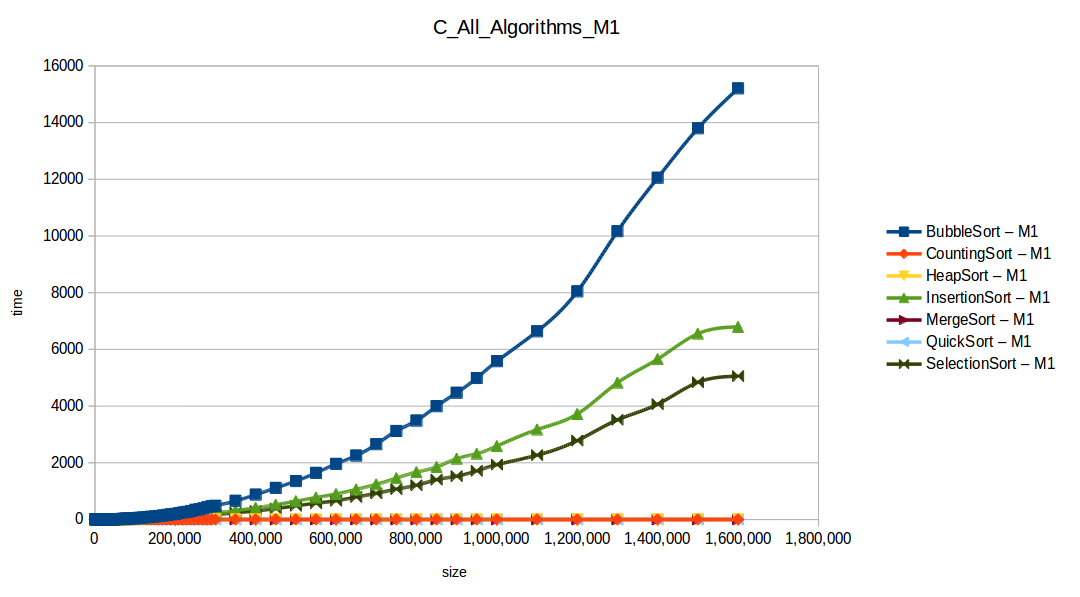Lua排序算法全攻略:性能对比与优化技巧
发布时间: 2024-09-10 05:04:06 阅读量: 153 订阅数: 61 


# 1. 排序算法的基础知识
在数据处理领域,排序算法是基本而核心的工具,它们负责将数据按照一定的顺序进行排列,以便后续的查询、分析和操作变得更加高效。对于Lua这样的轻量级编程语言,掌握排序算法的基础知识是进行高效编程的前提。
排序算法可以分为两大类:比较排序和非比较排序。比较排序依赖于元素间的比较操作来确定元素顺序,而非比较排序则利用了数据的特有属性来完成排序工作。常见的比较排序算法包括冒泡排序、选择排序、插入排序、归并排序、快速排序等,而非比较排序则有计数排序、桶排序、基数排序等。
理解排序算法的工作原理和复杂度分析,对于优化算法性能和处理大数据集至关重要。因此,本章节首先介绍排序算法的基础知识,包括排序算法的定义、分类和基本原理。这是深入探索排序算法、在实际开发中进行算法选择和优化的基石。接下来的章节将会深入探讨Lua语言中的内置排序功能,实现和分析经典排序算法,并通过实验对比它们的性能,最后分享优化技巧和实战应用案例。
# 2. Lua内置排序函数的探索
## Lua的内置排序函数概述
Lua作为一种轻量级的编程语言,拥有丰富的内置库,其中排序函数是许多开发者频繁使用的工具。Lua的排序函数`table.sort()`不仅可以对基本数据类型如数字和字符串进行排序,还能处理复杂的表结构排序,是Lua中十分强大的数据处理工具。
### `table.sort`的基本用法
在开始深入探讨之前,让我们先了解`table.sort`的基本用法:
```lua
table.sort(t [, comp])
```
其中`t`为要排序的表,`comp`是可选的比较函数,用于定义元素间的排序规则。如果不提供`comp`函数,那么排序默认按照升序进行。`table.sort`会就地排序,不会创建新的表。
## 排序原理与默认行为
### 默认排序行为
当`table.sort`不带比较函数时,默认是如何决定元素的排序顺序的呢?这里涉及到了Lua的泛型比较操作符。在Lua中,当需要比较两个值时,Lua会根据类型定义不同的比较规则,以字符串和数字为例:
- 字符串使用标准的字典序排序
- 数字则直接按照数值大小进行比较
### 泛型比较函数的深入
泛型比较函数是`table.sort`的基础,理解其内部机制有助于更高效地使用`table.sort`进行排序。例如,Lua 5.4 中引入了自定义比较函数,可以实现更复杂的比较逻辑,如考虑文化差异的字符串排序。
```lua
-- 自定义字符串比较,让排序更符合特定的文化习惯
function customCompare(a, b)
-- 实现自定义排序逻辑
end
table.sort(myTable, customCompare)
```
## 自定义比较函数的重要性
### 创建高效的自定义比较器
在实际应用中,经常需要按照特定的业务逻辑进行排序,这时就需要自定义比较函数。在Lua中,如何正确编写并优化这些比较函数至关重要,因为它们直接影响到排序的性能。
```lua
-- 排序函数,按时间戳排序
function sortByTimestamp(a, b)
return a.timestamp < b.timestamp
end
table.sort(logs, sortByTimestamp)
```
### 比较函数中的效率问题
编写比较函数时,一个常见的问题是性能瓶颈。由于排序算法的时间复杂度为O(n log n),因此比较函数的性能将在很大程度上影响整个排序过程。
```lua
-- 避免复杂度高的比较操作
function efficientCompare(a, b)
-- 优化逻辑,减少计算量
end
-- 不推荐的做法,可能会导致性能问题
function inefficientCompare(a, b)
-- 复杂且耗时的计算过程
end
```
## Lua 5.4 中的改进
### `table.sort`在Lua 5.4中的新特性
随着Lua 5.4的发布,`table.sort`有了新的改进,如更简洁的比较函数接口和更好的错误处理机制。这些改变增强了Lua的排序能力,特别是在处理大量数据时的稳定性和效率。
```lua
-- Lua 5.4版本中简化了比较函数的写法
table.sort(myTable, function(a, b) return a < b end)
```
### 改进对复杂数据结构的支持
Lua 5.4对复杂数据结构的支持亦有所加强,例如可以更容易地实现对嵌套表的排序:
```lua
-- 使用元表和元方法进行复杂的嵌套表排序
local metamethods = {
__lt = function(a, b)
-- 自定义比较嵌套表的逻辑
end
}
local nestedTable = setmetatable({}, metamethods)
table.sort(nestedTable)
```
## 总结
在本章中,我们探讨了Lua内置排序函数`table.sort`的核心功能与应用,对其背后的原理进行了深入分析,并讨论了如何通过自定义比较函数来实现更复杂的排序逻辑。随着Lua语言版本的演进,内置排序函数不断在提升性能、提高效率以及增强灵活性方面取得进展。在下一章中,我们将介绍经典排序算法在Lua中的实现与分析。
# 3. 经典排序算法在Lua中的实现与分析
在本章节中,我们将深入探讨在Lua语言中如何实现一些经典的排序算法。这将不仅包括算法的基本实现,还将包括对每种算法的时间复杂度和空间复杂度的分析,并通过代码示例,我们还将探讨这些算法在实际应用中的表现和效率。
## 3.1 简单排序算法
简单排序算法是最基本的排序方法,主要包括冒泡排序和选择排序。这些算法易于理解,但效率通常不如其他更高级的排序算法。
### 3.1.1 冒泡排序
冒泡排序是一种简单的排序算法,它重复地走访过要排序的数列,一次比较两个元素,如果他们的顺序错误就把他们交换过来。走访数列的工作是重复地进行直到没有再需要交换,也就是说该数列已经排序完成。
下面是冒泡排序在Lua中的基本实现:
```lua
function bubbleSort(t)
local n = #t
for i = 1, n do
for j = 1, n-i do
if t[j] > t[j+1] then
t[j], t[j+1] = t[j+1], t[j]
end
end
end
end
local arr = {3, 2, 1, 4, 5}
bubbleSort(arr)
print(table.concat(arr, ", ")) -- 输出排序后的数组
```
代码分析:
冒泡排序的每一趟都确保了最大的元素移动到数组的末尾。时间复杂度为O(n^2),这是因为算法包含两个嵌套循环。空间复杂度为O(1),因为它只需要常数级别的额外空间。
### 3.1.2 选择排序
选择排序算法是一种原址比较排序算法。选择排序大致的思路是找到数据结构中的最小值并将其放置在第一位,接着找到剩余最小值并将其放在第二位,如此这般重复下去,直至全部待排序的数据结构排完。
下面是选择排序在Lua中的基本实现:
```lua
function selectionSort(t)
local n = #t
for i = 1, n-1 do
local min_idx = i
for j = i+1, n do
if t[j] < t[min_idx] then
min_idx = j
end
end
t[i], t[min_idx] = t[min_idx], t[i]
end
end
local arr = {3, 2, 1, 4, 5}
selectionSort(arr)
print(table.concat(arr, ", ")) -- 输出排序后的数组
```
代码分析:
选择排序与冒泡排序不同,它通过一次遍历实现排序,而不是不断地交换元素。它每次从数组的未排序部分找到最小(或最大)的元素,然后将其放到已排序序列的末尾。时间复杂度也是O(n^2),但通常会比冒泡排序快一些,因为交换次数更少。空间复杂度为O(1)。
## 3.2 分治排序算法
分治排序算法是将原问题分解为若干个规模较小但类似于原问题的子问题,递归解决子问题,再合并其结果,从而得到原问题的解。下面我们将介绍两种分治排序算法:归并排序和快速排序。
### 3.2.1 归并排序
归并排序利用分治法的一个应用。它将已有序的子序列合并,得到完全有序的序列;即先使每个子序列有序,再使子序列段间有序。若将两个有序表合并成一个有序表,称为二路归并。
以下是归并排序在Lua中的实现:
```lua
function mergeSort(t)
if #t <= 1 then
return t
end
local mid = math.floor(#t / 2)
local left = mergeSort({table.unpack(t, 1, mid)})
local right = mergeSort({table.unpack(t, mid+1, #t)})
return merge(left, right)
end
function merge(left, right)
local result = {}
local i = 1
local j = 1
while i
```
0
0





